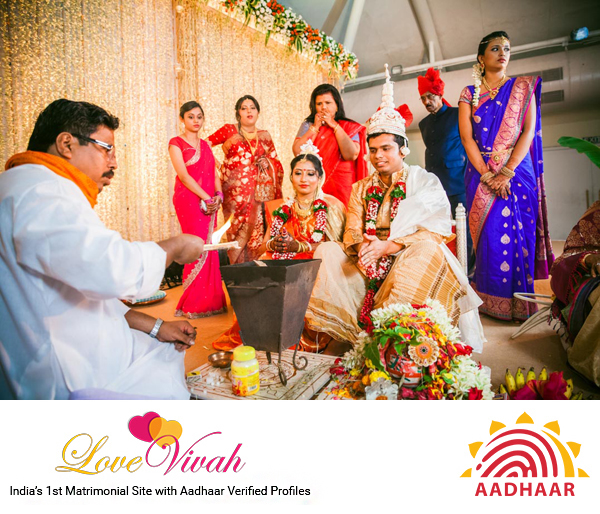Bengali wedding like any other wedding has its own flavor of traditions and rituals. If you have ever got a chance to witness any Bengali wedding, then you must have realized that it is filled with rituals and fun. Bengali Hindu weddings like most other Indian weddings are good mix of traditional customs and rituals. The wedding is union of two families. The parents of the Bengali boy and girl for marriage search life partner. The parents of the girl and boy fix marriage if they find the match suitable for their child. Generally, the Bengali weddings are not that fancy and gaudy as compared to weddings in North India. Let’s take a look at some of the pre-wedding rituals of Bengali wedding.
Adan-Pradan: Both the families fix a wedding date after getting the consent from the Bengali bride and groom for marriage. After checking the horoscope compatibility and other details, the families fix an auspicious marriage date.
Aashirwad ceremony: This is a ceremony where the bride and groom are formally accepted by both the families. All the family members shower the blessings on the would-be Bengali bride and groom. They put husked rice and trefoil leaves on their head. They also give gifts like gold jewelry, clothes, sweets and other things to the bride and groom. The day of this ceremony is not fixed as it varies from family to family. Some families conduct this ceremony a few days before, or a month before or on the wedding day.
Ai Budo Bhaat ceremony: This ceremony is very much similar to bridal shower of Christian wedding or bachelor party. The neighbors, close relatives and friends of the bride/groom attend this ceremony at her/his home before the wedding day. In this ceremony, the bride and groom offers a traditional Bengali meal in their respective homes as a ritual. It is considered as the last meal as bachelor or spinster.
Dodhi Mangal ceremony: This ceremony is held at the dawn of the wedding day. The family members and close relatives of the bride/groom visit a nearby river or pond where they can fill a pitcher with water and return home. They use this water during the holy snan ritual. After returning home, the would-be bride and groom have curd, rice flakes, banana and sweets in their respective homes as they are expected to fast the whole day till they complete all wedding ceremonies.
Nandi Mukh: This ceremony is performed on the wedding day morning just before the ‘gaye hould’ ceremony. It is performed in both the families. A priest chants Vedic incantations and extended family pay homage to their forefathers. A small puja is performed for the happy married life and seek blessing from their ancestors.
Tattava, Gae Hould and Snan: On the morning of the wedding, both the families send gifts and this ceremony is known as tattva. The groom’s family gift a new saree, oil, a big, decorated carp or rohu fish and some other gifts including jewelry, make-up kit, sweets and other edibles. The would-be-bride is supposed to wear the same saree during ‘gae holud’. The family members applied the turmeric paste on the face, hands and feet of the bride and groom in their respective families and this ceremony is populary known as gae holud in Bengal. Then the bride and groom take bath in the holy water brought in the morning from the river/pond for the snan.
Sankha and Pola: In all Bengali weddings, the brides is supposed to wear conch shell bangles which are red and white in color on the ai budo bhaat and in some families the bride wear these auspicious set of bangles on the wedding day morning after or during the gae hould. The white bangles are known as the sankha and the red bangles are called pola. These bangles are similar to the mangalsutra that a married woman wears in North India.
LoveVivah.com West Bengal matrimony portal gives profiles of brides and grooms for marriage. Search for Aadhaar matchmakings from Bengali matrimonial resumes.

